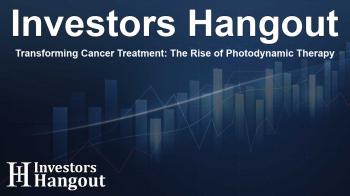Transforming Cancer Treatment: The Rise of Photodynamic Therapy

Understanding Photodynamic Therapy in Cancer Treatment
Photodynamic therapy (PDT) is gaining traction in the fight against cancer, offering a non-invasive, precise strategy for eliminating cancer cells while preserving healthy tissue. This innovative method employs a photosensitizing agent that specifically accumulates in cancer cells, activated by targeted light. Unlike conventional cancer treatments that often inflict significant damage to surrounding healthy tissues, PDT presents a promise of selective and effective therapy.
Innovations in Photodynamic Therapy
The global PDT landscape is evolving with ongoing advancements in photosensitizers and light delivery systems. A notable development is Sun Pharmaceutical's FDA-approved BLU-U Blue Light PDT Illuminator. Released recently, this device uses energy-efficient LED technology, enhancing patient comfort and operational efficiency. Its integration with LEVULAN KERASTICK for treating actinic keratoses signifies a paradigm shift towards more modern and user-friendly cancer therapies.
Case Study: Biofrontera's Ameluz®
Another landmark advancement in PDT is Biofrontera’s Ameluz®, recently showcased through a successful Phase 3 study. The study yielded significant results when administered with the RhodoLED lamp for the treatment of superficial basal cell carcinoma. With impending regulatory filings to widen its application horizons, the newly patented formulation free from propylene glycol positions Ameluz® favorably in the competitive oncology market.
Beyond Dermatology: Expanding Applications of PDT
PDT’s applicability extends beyond dermatological conditions. Emerging photosensitizers, such as padeliporfin, are currently being investigated for their effectiveness in addressing challenging internal cancers like intermediate-risk prostate cancer and locally advanced pancreatic cancer. This innovative approach specifically targets the tumor's vascular system, providing a viable solution for traditionally hard-to-treat malignancies.
The Role of Nanotechnology in PDT
Nanotechnology is pivotal in enhancing the efficacy of PDT. Scientists are developing multifunctional nanoplatforms that fuse imaging, therapy, and targeted drug delivery. These innovations not only maximize therapeutic impact but also mitigate side effects by directing photosensitizers precisely to cancer cells. Such advancements hold promise in the battle against drug-resistant cancers, improving patient outcomes through localized treatment.
PDT and Immunotherapy: A Synergistic Approach
The combination of PDT with immunotherapy represents a promising frontier in oncology. PDT can potentially stimulate an immune response by triggering immunogenic cell death, enhancing the effects of immune checkpoint inhibitors. The continual exploration of these combinations through upcoming clinical trials may yield groundbreaking therapies that leverage the strengths of both approaches.
Technological Innovations Shaping PDT
Recent technological breakthroughs in light delivery systems have transformed PDT’s accessibility. The advent of wearable and flexible light systems facilitates treatment, especially for patients requiring repeated therapies. Moreover, integrating artificial intelligence for real-time adjustments based on individual patient responses is revolutionizing personalized care in cancer treatment.
The Future of Photodynamic Therapy
Looking ahead, multi-photon PDT is set to broaden treatment capabilities by enabling deeper tissue penetration. This emerging technique uses longer-wavelength light for activating photosensitizers, thus expanding treatment options for previously inaccessible tumors. Continuous refinement in photosensitizers is anticipated to enhance procedure efficacy while minimizing adverse effects.
The surge in technological advancements signifies a broader trend towards individualized, minimally invasive cancer care. With ongoing clinical trials and innovation, PDT is poised to play a crucial role in a comprehensive strategy against cancer, promising significant advancements in patient management and outcomes across various cancer types.
Frequently Asked Questions
What is photodynamic therapy (PDT) in cancer treatment?
PDT is a non-invasive cancer treatment that uses light-sensitive drugs and a specific wavelength of light to kill cancer cells.
How does PDT differ from traditional cancer therapies?
PDT selectively targets cancer cells with minimal impact on surrounding healthy tissue, reducing side effects common with conventional therapies.
What recent advancements have been made in PDT?
Recent innovations include the use of LED technology in devices like the BLU-U Blue Light PDT Illuminator, making treatments more effective and user-friendly.
Can PDT be used for internal cancers?
Yes, emerging therapies are being developed for internal cancers, including innovative photosensitizers targeting vascular systems within tumors.
What is the future outlook for PDT in oncology?
The future of PDT looks promising with ongoing research, advancements in technology, and combinations with immunotherapies, suggesting a significant role in cancer treatment.
About The Author
Contact Henry Turner privately here. Or send an email with ATTN: Henry Turner as the subject to contact@investorshangout.com.
About Investors Hangout
Investors Hangout is a leading online stock forum for financial discussion and learning, offering a wide range of free tools and resources. It draws in traders of all levels, who exchange market knowledge, investigate trading tactics, and keep an eye on industry developments in real time. Featuring financial articles, stock message boards, quotes, charts, company profiles, and live news updates. Through cooperative learning and a wealth of informational resources, it helps users from novices creating their first portfolios to experts honing their techniques. Join Investors Hangout today: https://investorshangout.com/
The content of this article is based on factual, publicly available information and does not represent legal, financial, or investment advice. Investors Hangout does not offer financial advice, and the author is not a licensed financial advisor. Consult a qualified advisor before making any financial or investment decisions based on this article. This article should not be considered advice to purchase, sell, or hold any securities or other investments. If any of the material provided here is inaccurate, please contact us for corrections.

